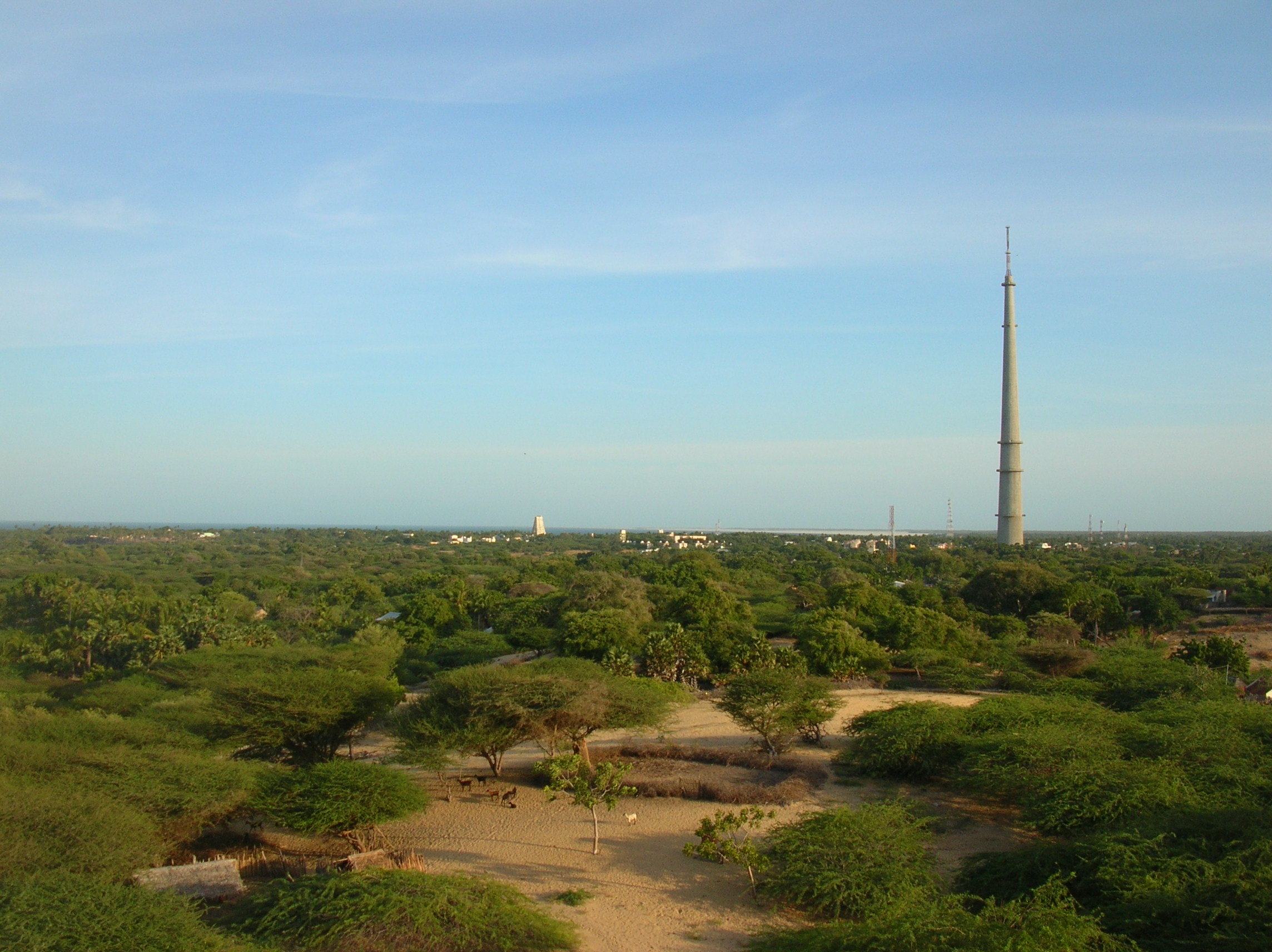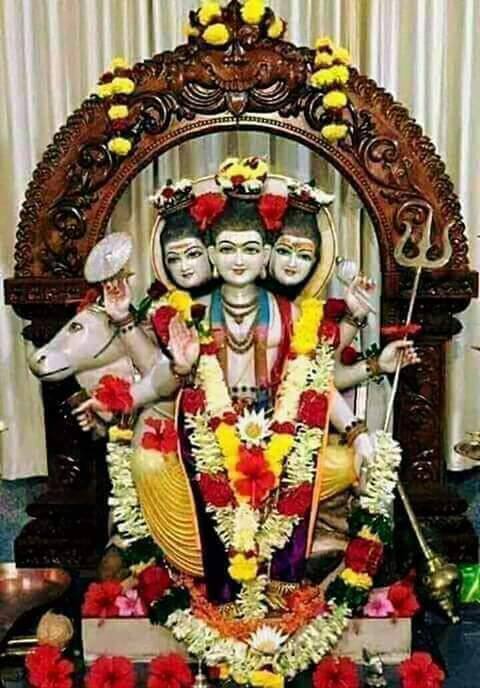|
Mount Gandhamadana
Mt. Gandhamadana is the tallest peak on Pamban Island which lies in the Palk Strait between mainland India and Sri Lanka. It is believed by many people that Lord Hanuman resides there. Location Gandhamadana is located 3 kilometres from Rameswaram, almost midway between the western edge of the island and the ghost-town of Dhanushkodi at the corner of the eastern promontory. History Mt. Gandhamadana is believed to be the hillock from whose summit, the Rama-devotee Hanuman, commenced his flight to Ravana's Lanka. Kalidasa umarasambhava, VIrefers to Gandhamadana, in the vicinity of the mythical city of Osadhiprastha in Himalaya Mountain, having Santanaka trees. Nath tradition holds that Parashurama, after enacting his vengeance, sought out Dattatreya atop Mount Gandhamadana for spiritual guidance. Their conversations gave rise to Tripura Rahasya, a treatise on Advaita Vedanta. It was here the deity A deity or god is a supernatural being who is considered divine or sacred. ... [...More Info...] [...Related Items...] OR: [Wikipedia] [Google] [Baidu] |
Nath
Nath, also called Natha, are a Shaiva sub-tradition within Hinduism in India and Nepal. A medieval movement, it combined ideas from Buddhism, Shaivism and Yoga traditions in India.Natha: Indian religious sect Encyclopedia Britannica (2007) The Naths have been a confederation of devotees who consider , as their first lord or , with varying lists of additional gurus. Of these, the 9th or 10th century |
Mountains Of Tamil Nadu
A mountain is an elevated portion of the Earth's crust, generally with steep sides that show significant exposed bedrock. Although definitions vary, a mountain may differ from a plateau in having a limited summit area, and is usually higher than a hill, typically rising at least 300 metres (1,000 feet) above the surrounding land. A few mountains are isolated summits, but most occur in mountain ranges. Mountains are formed through tectonic forces, erosion, or volcanism, which act on time scales of up to tens of millions of years. Once mountain building ceases, mountains are slowly leveled through the action of weathering, through slumping and other forms of mass wasting, as well as through erosion by rivers and glaciers. High elevations on mountains produce colder climates than at sea level at similar latitude. These colder climates strongly affect the ecosystems of mountains: different elevations have different plants and animals. Because of the less hospitable terrain and ... [...More Info...] [...Related Items...] OR: [Wikipedia] [Google] [Baidu] |
Deity
A deity or god is a supernatural being who is considered divine or sacred. The ''Oxford Dictionary of English'' defines deity as a god or goddess, or anything revered as divine. C. Scott Littleton defines a deity as "a being with powers greater than those of ordinary humans, but who interacts with humans, positively or negatively, in ways that carry humans to new levels of consciousness, beyond the grounded preoccupations of ordinary life". Religions can be categorized by how many deities they worship. Monotheistic religions accept only one deity (predominantly referred to as "God"), whereas polytheistic religions accept multiple deities. Henotheistic religions accept one supreme deity without denying other deities, considering them as aspects of the same divine principle. Nontheistic religions deny any supreme eternal creator deity, but may accept a pantheon of deities which live, die and may be reborn like any other being. Although most monotheistic religions traditionall ... [...More Info...] [...Related Items...] OR: [Wikipedia] [Google] [Baidu] |
Advaita Vedanta
''Advaita Vedanta'' (; sa, अद्वैत वेदान्त, ) is a Hinduism, Hindu sādhanā, a path of spiritual discipline and experience, and the oldest extant tradition of the Āstika and nāstika, orthodox Hindu school Vedanta, Vedānta. The term ''Advaita'' (literally "non-secondness", but usually rendered as "nondualism", and often equated with monism) refers to the idea that ''Brahman'' alone is ultimately Satya, real, while the transient phenomenon (philosophy), phenomenal world is an illusory appearance (''Maya (religion), maya'') of Brahman. In this view, (''jiv)Ātman (Hinduism), Ātman'', the experiencing self, and ''Ātman-Brahman'', the highest Self and ultimate Reality, Absolute Reality, is non-different. The ''jivatman'' or individual self is a mere reflection or limitation of singular ''Ātman'' in a multitude of apparent individual bodies. In the Advaita tradition, ''moksha'' (liberation from suffering and rebirth) is attained through recogni ... [...More Info...] [...Related Items...] OR: [Wikipedia] [Google] [Baidu] |
Tripura Rahasya
The Tripura Rahasya (Devanagari: त्रिपुरा रहस्य, ) meaning ''The Mystery beyond the Three cities'', is an ancient literary work in Sanskrit believed to have been narrated by Dattatreya to Parashurama. It is an ancient prime text which is one of the treatises on Advaita school of classical Indian Metaphysics. Textual History and Structure Tripurā means "three cities" or "the trinity." Rahasya means "secret" or "mystery." In a sense there is no secret to be revealed. It is only due to lack of wisdom that humans don't experience their true nature. Therefore, mystery would be a more appropriate translation. Thus, Tripura Rahasya means the Mystery beyond the Trinity. The three cities or states of consciousness are waking (Jāgṛat), dreaming (Svapna) and deep sleep (Suṣupti). The underlying consciousness in them all is called Sri Tripura, the Mother Goddess Tripura Sundari. The Tripura Rahasya expounds the teachings of the supreme spiritual truth. The high ... [...More Info...] [...Related Items...] OR: [Wikipedia] [Google] [Baidu] |
Tantras
Tantras ("''doctrine''" or "''framework''" or "''system''" ) refers to numerous and varied scriptures pertaining to any of several esoteric traditions rooted in Hindu and Buddhist philosophy. The religious culture of the Tantras is essentially Hindu, and Buddhist Tantric material can be shown to have been derived from Hindu sources. And although Hindu and Buddhist Tantra have many similarities from the outside, they do have some clear distinctions. The rest of this article deals with Hindu Tantra. Buddhist Tantras are described in the article on Buddhist Tantras. Classes of Hindu Tantra The word ''tantra'' is made up by the joining (''sandhi'' in Sanskrit) of two Sanskrit words: ''tanoti'' (expansion) and ''rayati'' (liberation). Tantra means liberation of energy and expansion of consciousness from its gross form. It is a method to expand the mind and liberate the dormant potential energy, and its principles form the basis of all yogic practices. Hence, the Hindu Tantra scriptur ... [...More Info...] [...Related Items...] OR: [Wikipedia] [Google] [Baidu] |
Dattatreya
Dattatreya ( sa, दत्तात्रेय, ), Dattā or Dattaguru, is a paradigmatic Sannyasi (monk) and one of the lords of yoga, venerated as a Hindu god. In Maharashtra, Goa, Andhra Pradesh, Telangana, Karnataka, Gujarat, and Madhya Pradesh he is a syncretic deity, In Bengal he is known as 'Trinath', avatar of the three Hindu gods Brahma, Vishnu, and Shiva, who are also collectively known as the Trimurti. In other regions, and some versions of texts such as Garuda Purana, Brahma Purana and Sattvata Samhita, he is an avatar of Vishnu only. Several Upanishads are dedicated to him, as are texts of the Vedanta-Yoga tradition in Hinduism. One of the most important texts of Hinduism, namely Avadhuta Gita (literally, "song of the free soul") is attributed to Dattatreya. Over time, Dattatreya has inspired many monastic movements in Shaivism, Vaishnavism, and Shaktism, particularly in the Deccan region of India, south India, Gujarat, Madhya Pradesh, Rajasthan and Himalayan regi ... [...More Info...] [...Related Items...] OR: [Wikipedia] [Google] [Baidu] |
Lanka
Lanka (, ) is the name given in Hindu epics to the island fortress capital of the legendary asura king Ravana in the epics of the ''Ramayana'' and the ''Mahabharata''. The fortress was situated on a plateau between three mountain peaks known as the Trikuta Mountains. The ancient city of Lankapura is said to have been burnt down by Hanuman. After its king, Ravana was killed by Rama with the help of Ravana's brother Vibhishana, the latter was crowned king of Lankapura. His descendants were said to still rule the kingdom during the period of the Pandavas. According to the ''Mahabharata'', the Pandava Sahadeva visited this kingdom during his southern military campaign for the rajasuya of Yudhishthira. Ramayana The island was situated on a plateau between three mountain peaks known as the Trikuta Mountains. The ancient city of Lankapura is thought to have been burnt down by Hanuman. After its king, Ravana was killed by Rama with the help of Ravana's brother Vibhishana, the latt ... [...More Info...] [...Related Items...] OR: [Wikipedia] [Google] [Baidu] |
Palk Strait
The Palk Strait ( ta, பாக்கு நீரிணை ''Pākku Nīriṇai'', si, පෝක් සමුද්ර සන්ධිය ''Pok Samudra Sandhiya'') is a strait between the Tamil Nadu state of India and the Jaffna District of the Northern Province of the island nation of Sri Lanka. It connects the Bay of Bengal in the northeast with Palk Bay in the southwest. With a minimum depth of less than 9.1 m,Palk Bay Sea Seek. it is 40 to 85 miles (64 to 137 km) wide and 85 miles long.Palk Strait Encyclopedia britannica. Several rivers flow into it, including the |
Ravana
Ravana (; , , ) is a rakshasa king of the island of Lanka, and the chief antagonist of the Hindu epic ''Ramayana'' and its adaptations. In the ''Ramayana'', Ravana is described to be the eldest son of sage Vishrava and rakshasi Kaikesi. He abducted Prince Rama's wife Sita and took her to his kingdom of Lanka, where he held her in the Ashoka Vatika. Later, Rama, with the support of vanara King Sugriva and his army of vanaras, launched an invasion against Ravana in Lanka. Ravana was subsequently slain and Rama rescued his beloved wife Sita. Ravana is widely portrayed to be an evil character, though he also has many qualities that make him a learned scholar. He was well-versed in the six shastras and the four Vedas. Ravana is also considered to be the most revered devotee of Shiva. Images of Ravana are seen associated with Shiva at some temples. He also appears in the Buddhist Mahayana text ''Laṅkāvatāra Sūtra'', in Buddhist Ramayanas and Jatakas, as well as in Jain Ra ... [...More Info...] [...Related Items...] OR: [Wikipedia] [Google] [Baidu] |
Hanuman
Hanuman (; sa, हनुमान, ), also called Anjaneya (), is a Hindu god and a divine '' vanara'' companion of the god Rama. Hanuman is one of the central characters of the Hindu epic ''Ramayana''. He is an ardent devotee of Rama and one of the Chiranjivis. Hanuman is regarded to be the son of the wind-god Vayu, who in several stories played a direct role in Hanuman's birth, and considered to be an incarnation or son of Shiva in Shaivism. Hanuman is mentioned in several other texts, such as the epic ''Mahabharata'' and the various Puranas. Evidence of devotional worship to Hanuman is largely absent in these texts, as well as in most archeological sites. According to Philip Lutgendorf, an American Indologist, the theological significance of Hanuman and devotional dedication to him emerged about 1,000 years after the composition of the ''Ramayana'', in the 2nd millennium CE, after the arrival of Islamic rule in the Indian subcontinent.Paula Richman (2010), ''Review: Lut ... [...More Info...] [...Related Items...] OR: [Wikipedia] [Google] [Baidu] |










